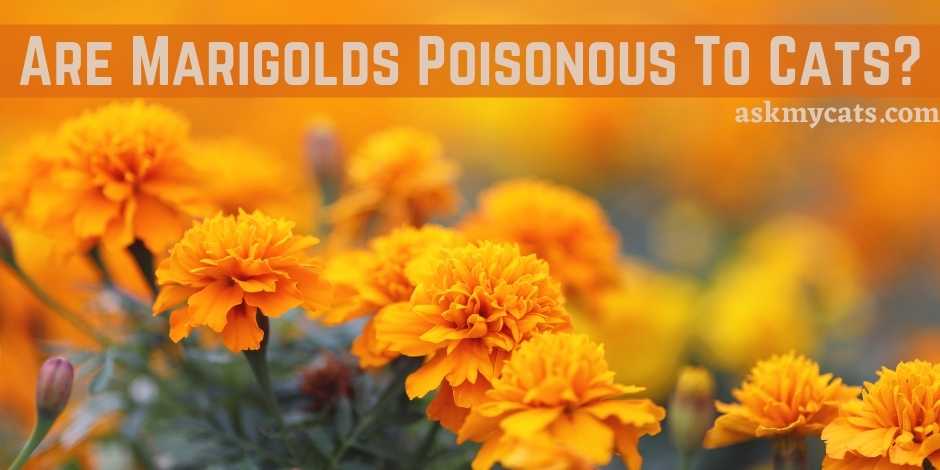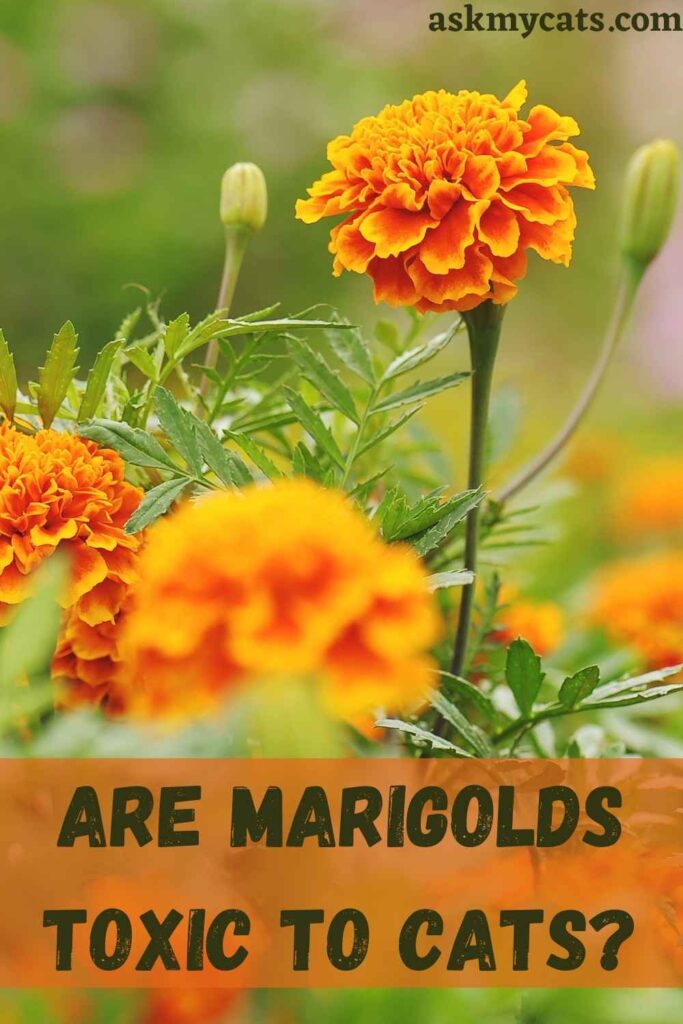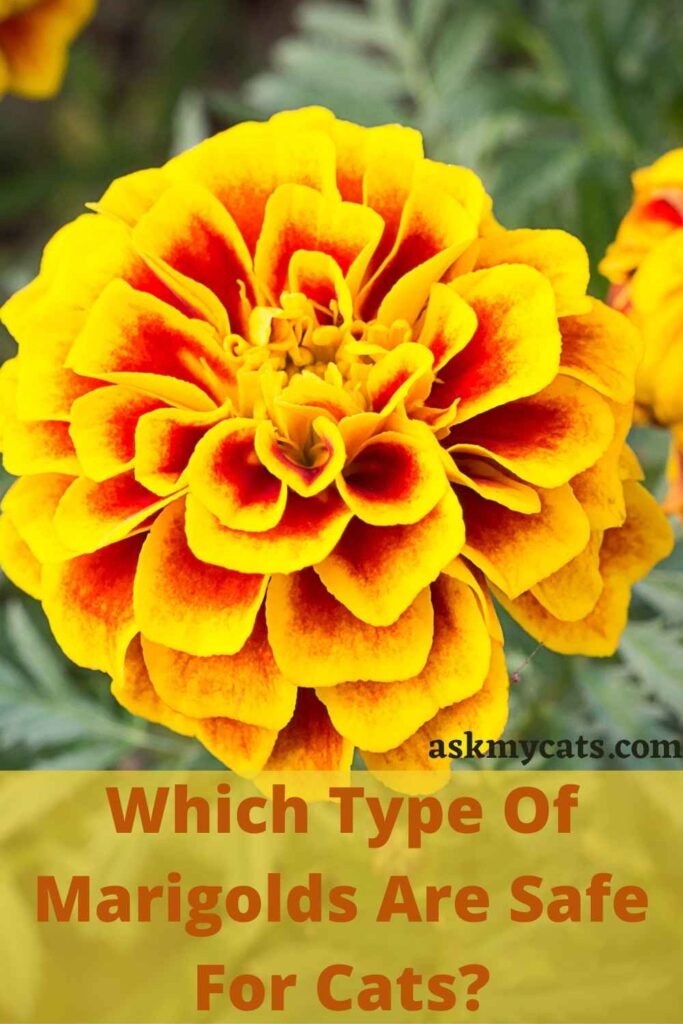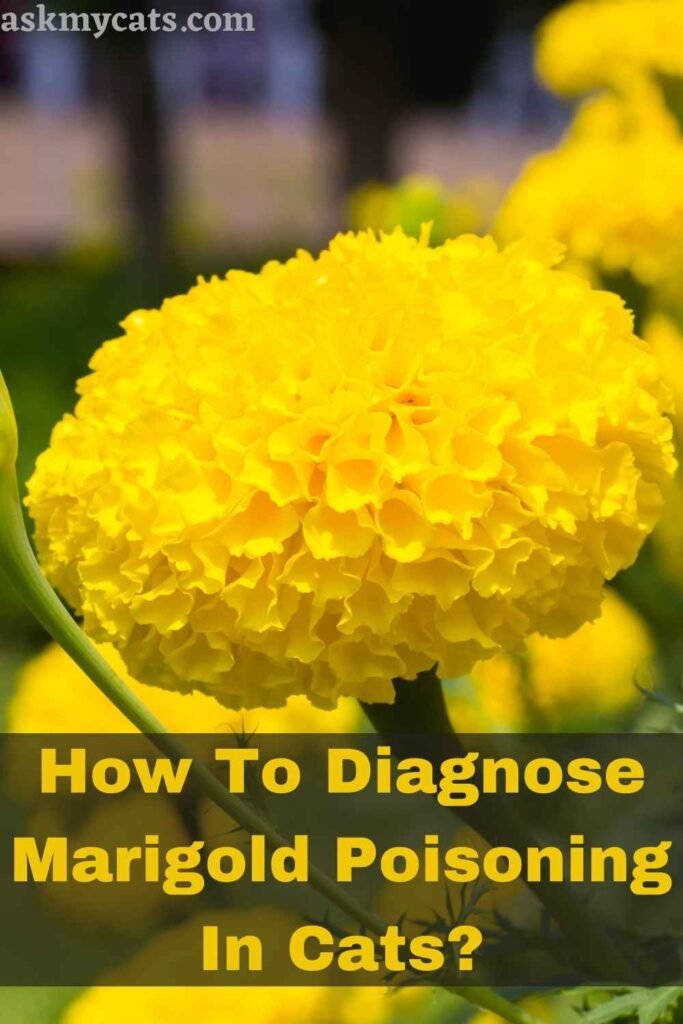Having a cat can be stressful, especially if you or your neighbours enjoy gardening. While some plants, flowers, and herbs are excellent in promoting healthy soil and a perfect mini-ecosystem, there are a number of plants that are exceedingly toxic to cats and can even be fatal.
Marigolds are one of the most commonly planted flowers in gardens because they are brilliant and attract a variety of beneficial insects. Marigolds are also known to repel pests such as worms.
However, are marigolds poisonous to cats?
No, marigolds are not poisonous to cats. Marigolds are classified into two types: Calendula Officinalis, also known as pot marigolds, and Tagetes, also known as French Marigolds. Cats and dogs are both unaffected by pot marigolds. French marigolds are toxic and will cause a mild form of gastric upset if consumed by either a cat or a dog.
This article will talk about how cats and marigolds can co-exist and things you need to look out for.


Give Your Cat the Perfect Day
Get the Free Ebook!
What Are Marigolds?
Tagetes is a genus of annual or perennial, mostly herbaceous plants in the sunflower family Asteraceae. They are among several groups of plants known in English as marigolds.
Marigold species range in height from 0.1 to 2.2 m. The majority of species have pinnate green leaves.
Blooms are naturally golden, orange, yellow, and white, with maroon highlights. Floral heads range in size from 1–4–6 cm in diameter and contain both ray and disc florets.
They are typically planted as annuals in horticulture, though perennial species are gaining popularity. Their roots are fibrous.
Marigolds grow well in almost any soil, depending on the species. Most horticultural selections thrive in well-drained soil, and some cultivars are known to be drought tolerant.
Marigold foliage has a musky, pungent scent depending on the species, though some varieties have been bred to be scentless.
Some common insect pests, as well as nematodes, are said to be deterred by it. As a result, Tagetes species, particularly T. patula, are frequently used as companion plants for tomato, eggplant, chilli pepper, tobacco, and potato.
Tagetes should not be planted near any legume crop due to the antibacterial thiophenes exuded by the roots. Some perennial species are resistant to deer, rabbits, rodents, javelinas, and peccaries.
Marigolds are low-maintenance once established, and they are pest-free. In fact, they are sometimes planted to deter pests that prey on other plants.
Marigolds can bloom almost continuously and will continue to bloom until frost. Keep your marigolds deadheaded to achieve nonstop flowering. Flowering may slow slightly during the summer heat, but it usually resumes in full force once cooler weather arrives.
Are Marigolds Toxic To Cats?
Pot marigolds are not toxic to cats.

You’ve probably come across conflicting information if you’ve been researching whether marigolds are safe for cats to eat.
Some websites classify marigolds as toxic to cats, while others classify them as safe to feed to cats.
The Cat Fanciers’ Association, for example, classifies marigolds as poisonous, whereas the ASPCA’s Animal Poison Control Center classifies the flower as nontoxic.
The type of marigold you’re reading about could be the source of your confusion.
The ASPCA lists calendula officinalis, also known as pot marigold, as a plant that is not toxic to cats.
There is, however, the tagetes form of marigold, which can be toxic to cats. If your cat comes into contact with this type of marigold, she may experience skin irritation, especially in and around her mouth if she has been chewing on it.
If you notice signs that she has been playing in marigolds, wash the affected area of her coat with mild soap and water.
It’s also a good idea to contact your veterinarian to find out what other reactions you should be on the lookout for.
Always seek the advice of an experienced veterinarian when it comes to your pet’s health and treatment.
Ruddles, calendula, Mary bud, gold bloom, Scotch marigold, and common marigold are all names for pot marigolds.
These are safe to plant in your garden where your pet or stray may visit, and they also have numerous health benefits for humans.
Not only are they edible, but they can also be used as an antiseptic and topical anti-inflammatory in herbal medicine.
On the other hand, bushy and compact French marigolds are easy to grow and maintain. French marigolds have single, double, semi-double, or crested flowers and can grow to be 6 to 12 inches tall.
The flowers are available in a variety of colours, including yellow, orange, and red, as well as a unique bronze colour.
However, as lovely as these flowers appear, they are not safe to plant if you have a cat or dog nearby and should be avoided unless you want to rush your furry friend to the vet.
So the good news is that if you adore marigolds and must have them in your garden or home, you can do so without endangering your cat or dog. Your cat will be safe as long as you buy pot marigolds. Which
Which Type Of Marigolds Are Safe For Cats?
Only pot marigolds are safe for cats.

If you enjoy marigolds and have cats, consider growing the pot marigold, a beautiful, non-toxic member of the marigold family.
The flowers of the pot marigold, on the other hand, are edible (for humans) raw or blanched, fresh or dry, sweet or savory, and can be found garnishing salads and gourmet dishes in the finest restaurants.
When looking for a pot marigold, remember that this plant is also known as the calendula, ruddles, Mary bud, gold bloom, common marigold, or Scotch marigold.
Others that are edible include “Tangerine Gem,” “Lemon Gem,” and “Red Gem.”
These marigolds are an excellent choice for a flower garden in a backyard or other area frequented by your dogs or cats.
Low-maintenance Pot marigolds produce large flowers in warm hues of yellow, red, and orange all summer long and are only intolerant of intense heat and long periods of hot, humid weather. These are flowers that add rich colour to your garden, are easy to care for, and are cat-friendly.
According to VCA Hospitals, “Calendula (Calendula officinalis), also known as pot marigold, is a popular topical anti-inflammatory and antiseptic in herbal medicine.
Its soothing effect is due to its ability to scavenge free radicals (inflammatory products) and inhibit lymphocyte proliferation (a white blood cell associated with the immune system).”
Indeed, calendula is both medicinally beneficial and aesthetically pleasing in your cat-friendly garden.
Signs Of Marigold Poisoning In Cats?
Symptoms of marigold poisoning include: –
- Vomiting
- Drooling
- Diarrhea
- Stomach pain.
- Irritation around the eyes, nose, and mouth.
- Redness of the skin.
- Irritation of mucous membranes.
If you suspect your cat has had skin contact with marigold sap or has ingested any of the plant, which may be obvious because some plant matter may be present around their mouth, look for the above-mentioned symptoms and seek veterinary consultation or professional advice from an animal poison helpline.
In comparison to other more toxic plants, marigolds, specifically, the tagetes type, cause only mild irritation to your furry friend’s gastrointestinal tract if consumed.
Marigold toxicity is relatively mild; however, pet owners should be concerned about consumption hand exposure.
Marigold toxicity can be severe depending on how much has been consumed or how much exposure has occurred, as well as your cat’s overall health, age, and immune system function.
If your cat has been exposed to marigolds, don’t take it lightly and seek medical attention right away.
How To Diagnose Marigold Poisoning In Cats?
If your cat has ingested marigold and is showing signs of poisoning take her to the vet for a proper diagnosis.

If you discover your cat eating plants from a garden or if there’s any plant material in or near your cat’s mouth, you should contact your veterinarian to ensure your cat hasn’t eaten anything poisonous.
It’s also worth remembering that pesticides may have been used on nearby gardens or plants.
Although the marigold the cat ate isn’t harmful, the herbicide is.
Because cats’ digestive systems aren’t built to handle foliage and flowers, a blockage could form if the cat has trouble digesting the plant stuff.
It’s critical to bring a plant sample for the veterinarian to examine. The cat’s diagnosis and treatment will be heavily influenced by the plant’s species identification.
If the symptoms the cat is displaying are comparable to those of an illness with similar symptoms, and examining veterinarian may order tests such as a complete blood count, urinalysis, and faecal analysis.
A veterinarian will palpate the cat’s abdomen to see whether any plant matter is present that could cause an obstruction. The veterinarian will inspect the cat’s skin and fur if it has been exposed to marigold sap.
If your cat has come into touch with the sap, you should wash the affected area with a bar of gentle soap before going to the clinic. This will keep the skin from becoming irritated any further.
What To Do If Cat Ingested Marigolds?
If your cat ingested marigolds take her to the vet immediately.
According to the Pet Poison Helpline, marigolds, specifically plants of the tagetes species, cause only mild irritation to the gastrointestinal tract when ingested by cats or dogs, in contrast to some of the more severe effects of some plants’ toxicity.
In addition, if exposed to the sap of marigold plants and flowers, dogs and cats may develop a skin rash.
While marigold toxicity is considered mild in comparison to some of the most severe adverse reactions to a number of toxic plants, it is cause for concern.
The amount ingested, as well as the cat’s health, age, and immune system status, may cause a more severe reaction than the typical mild one.
It’s always a good idea to consult one of the animal poison control centres, call your veterinarian, or go to the veterinary emergency clinic so that they can properly assess and treat your beloved cat.
Be proactive and always be prepared for a pet poisoning emergency by programming your phone with your veterinarian’s phone number, as well as the phone number of the nearest emergency vet clinic, the 24/7 ASPCA Poison Control Center (888) 426-4435 (a consultation fee may apply), and the Pet Poison Helpline’s number 855-764-7661.
Pet Poison Helpline is a 24-hour independent, nationally recognized, triple-licensed animal poison control centre that serves pet parents in the United States, Canada, and the Caribbean.
Of course, prevention is always the best option, when it comes to toxic plants and cats coexisting.
Your cat’s treatment will be determined by how it reacts to the ingestion of marigolds. The age and current health status of the cat may also have an impact on treatment.
Cats with kidney problems will have a more difficult time eliminating the toxins in the marigold. This may aggravate the condition and necessitate a different course of treatment.
The veterinarian’s treatment will primarily focus on alleviating the symptoms of poisoning. Cats who vomit excessively will be given intravenous therapy to keep their electrolyte and hydration levels stable.
This will assist the liver and kidneys in eliminating marigold toxins from the body. An antiemetic may also be administered.
Sap-affected areas will be cleaned. A soothing ointment will be applied after the fur and skin have been washed.
Frequently Asked Questions
How to identify toxic marigolds?
For centuries, beautiful ornamental flowers, compact and bushy French marigolds, have been cultivated. They are a go-to for savvy gardeners because they are simple to grow and care for. However, if you have pets, be aware that they can cause gastric upset if ingested and dermal irritations if the skin is exposed to the plant’s sap. The daisy family includes tagetes patula or French marigolds, which are native to the Americas. French marigolds are tough annuals that grow 6- to 12-inches tall and have 1- to 2-inch-diameter single, semi-double, double, or crested flowers. The flower heads can be yellow, orange, red, a distinctive bronze color, or bicolor. The aromatic, pinnate leaves are toothed and arranged like a feather, with lance-shaped leaflets on opposite sides of a common axis.
What kind of plants can cats eat?
Catnip, cat thyme, oat grass, rosemary, and bean sprouts, as well as zinnias, marigolds, and Johnny-jump-ups, are popular edible flowers for cats. Although catnip has a reputation for being a cat favourite, you should try some on your cat before planting it because not all cats enjoy it.
What is so special about marigolds?
Marigolds are actually one of the most popular flowers to plant in gardens because they are bright and will attract a number of beneficial insects. Marigolds are also known to deter harmful creatures like worms.
Final Words
When you’re a cat parent, you know that not all marigolds are created equal.
If you’re looking for that sunrise/sunset-hued pop for your garden, learn to identify the different types of marigolds and be aware of the various names that toxic marigolds may be labelled within different stores or nurseries so you can avoid them.
In addition, if your cat comes into contact with or ingests a toxic marigold while visiting family or friends or in a public park, seek veterinary advice.
If you have any questions, ask us in the comments section.
